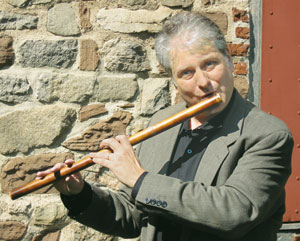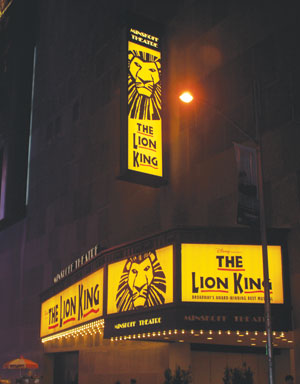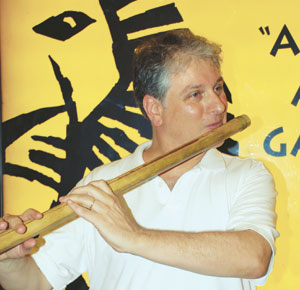David Weiss has collected over 80 wooden flutes from around the world. For years he has searched out unusual instruments, repaired, and learned to play them. From Broadway to commercials, he is much in demand for their haunting, unusual sounds.
.jpg) “There are a few of us around on the planet who are known as ethnic flute players,” says David Weiss. We met this past August at the National Flute Association convention in New York City, probably one of the few places in the United States where an ethnic flute player can make a living. He is a New Yorker, through and through: he grew up there, was educated there, and has worked on Broadway and in the New York freelance scene his entire life.
“There are a few of us around on the planet who are known as ethnic flute players,” says David Weiss. We met this past August at the National Flute Association convention in New York City, probably one of the few places in the United States where an ethnic flute player can make a living. He is a New Yorker, through and through: he grew up there, was educated there, and has worked on Broadway and in the New York freelance scene his entire life.
Both of his parents are professional musicians. “My mother was a Joseph Mariano student at the Eastman School of Music, where she met my father, who was a clarinet student. That’s how all this started.” Weiss gestures to the more than 80 ethnic flutes that he owns and plays.
After a short stint in Los Angeles, where Weiss was born in 1959, the family moved to New York City, where his father had been offered a full-time job playing at Radio City Music Hall. “My Mom studied with Julius Baker on and off, and I saw a lot of him as a kid. At the time I didn’t realize how special he was. We lived on the Upper West Side on 74th street, and “Uncle Julie” lived just down the street. My parents became good friends with Julie and Ruth Baker, and I played with their children.”
Education
“I studied with Baker’s students a lot. Mom was my first teacher, but I was a bit rebellious. I started with Thomas Nyfenger when I was in junior high. However, I also wanted to play jazz and rock and roll, and I was really into electronics. Anything that guitar and synthesizer players were using, I wanted to try on the flute – fuzz boxes, octave splitters, ring modulators, etc. I also started doubling on the saxophone about that time, and Nyfenger didn’t really approve. I had a very hard time being a good flutist when I was playing a lot of saxophone.
"During high school I went to study with Joe Allard in New Jersey. He was the patron saint of saxophone teachers in the U.S. – just a brilliant, French-Canadian gentlemen who showed me how to do my saxophone embouchure differently. That was the key. After that it was much easier to double flute and saxophone. Even then, though, I was spending a significant majority of my time practicing flute.”
Weiss also studied with the noted New York doubler Al Regni during high school but admits that “I just wasn’t putting in the hours at that point. Al was a great teacher, but I was still too much of a teenager. When I was about 16, I started studying with Erich Graf, who is now the principal of the Utah Symphony. He was teaching at The Summer Music Program at Bowdoin College in Maine, and something about working with him lit a spark. I started practicing eight hours a day. Bowdoin was sort of like a Juilliard summer school. Everybody practiced all day, so I did too.

Interest in Ethnic Flutes
“After that I started playing all the time. I actually switched high schools so I didn’t have a big workload. I went to an alternative education high school and that left time for me to play all kinds of music. At age 17 I went down to Soho to hear avant garde jazz. I also studied contemporary flute music and other types of music on top of my main studies in classical and jazz flute.
“That was when I started getting into world music. In New York, just walking down the street you can hear Latin charanga and salsa, African music, Nigerian drumming, and Brazilian bossa nova. My parents also had a very eclectic record collection. I remember looking around in the back of funky old music stores to see if they had any old flutes lying around. Most of them were in terrible shape, and it took me a long time to learn how to make them playable. That is how I learned about keyless wood instruments. I love the sound of wood flutes, as well as off-the-beaten-track woodwinds.”
For college Weiss chose the Manhattan School of Music because he wanted to stay in New York. He planned on working there after graduation, doing Broadway shows, recording, free-lancing, and jazz. He has been employed on Broadway since 1983, and also does lots of studio work.
“I didn’t see myself sitting in an orchestra, although I love the orchestral repertoire. During conservatory I studied with Andy Lolya and Harold Bennett at Manhattan. I also had several semesters with Harvey Sollberger, who showed me so many unusual and wonderful things. He was a very enthusiastic teacher.
“In the early 1980s, I studied flute and saxophone with the noted New York studio musician Harvey Estrin, one of the best moves I ever made. Harvey was the toughest teacher I ever had in anything, a real drill instructor. Nothing was ever good enough, so it made me work even harder. He may have been my most influencial teacher.”
Broadway
Weiss’ first Broadway show with wood flutes was Pacific Overtures, a Sondheim show in 1984. “The word got out that I had a bag of flutes. Davey Bag O’ Flutes someone jokingly called me. It’s actually a difficult thing to do – to have all the instruments work, play in tune, and have a certain something that is enjoyable to listen to.
“I started doing a bit of session work after that. I was still learning, buying instruments, and trying to figure out what I was doing. Miss Saigon in 1991 was a big break through for me. The flute book in that show had a fair amount of wood flute solos, and we were only the second company in the world to do the show after the London premiere. In London they had used different instruments from what I had. I tried sopranino Chinese flutes and a few other Chinese and Indian flutes. The composer really loved the way it sounded. After that, they used those instruments in the subsequent companites. To this day, I am still renting out instruments for that show.

The Lion King
“In the summer of 1996 I got a call from Michael Keller, a New York music contractor. He told me that Disney was turning the movie Lion King into a musical, and he wanted to know if I would be interested. It meant leaving Miss Saigon, which promised to be a steady job for at least a few more years, but something told me this was going to be big. I said I was interested, and we made a date to talk. I would have to audition in the future. This all leads to a funny story.
“In October of 1996 I got a call from the film composer Mark Manchina, who was assuming the job of music supervisor for Lion King. He wanted to meet me, but I was booked solid. That night, unbeknownst to me, he and two other people from Disney came to Miss Saigon, thinking they would hear me play. I was off that night, and unbeknownst to them, they heard my sub. They called the next day to say they had enjoyed my work the night before. I cried, ‘Wait – that wasn’t me.’ We made tentative plans to meet soon.
“The following night the same three men showed up at the Miss Saigon, again unannounced. At intermission, they came looking for me at the orchestra pit, which is very deep. To talk to them, I had to stand on my chair and have the job interview in front of the whole orchestra. When it was time to tune, the conductor said, “Dave,” and I replied, ‘Wait. This is important. I’ll be done in a second!’ My friends still give me the business over that one.”
The development of every Broadway show begins with what is called a workshop. That is followed by the Out of Town Break In, a pre-Broadway production of the show.
The Workshop
The entire music creative team (composers, orchestrators, actors, and a few players) start throwing out concepts and musical examples and work with them to come up with the score. “Every show is different. I had never heard of a musical workshop as extensive as what Disney did for Lion King. They had the movie score, but the Broadway show was going to be expanded by an hour. Some numbers that had been cut from the movie were added to the show. Disney rented out the Sony Studios here in New York for about a week and hired about 12 of us, about half the size of a traditional show band, and threw charts at us. We tried things out in multiple ways. I introduced the creative team to a variety of instruments that they were not familiar with, including the bass panpipe, ocarinas, and a variety of wood flutes. It went quite well, and after a few days they offered me the job.
The Out of Town Break In
“In June of 1997 we held further meetings and rehearsals in New York, now really defining what we were going to be doing. I took about 80 instruments with me. The only thing the Disney people had specified was that they wanted panpipes, flute, and piccolo. Eveything was being made up as we went. I was also asked to contribute to the flute parts, sometimes by improvising in rehearsal.
“The entire production moved to Minneapolis in June of 1997 where we worked out the details and had our first preview. I had only worked out about 2/3 of the solos, and some of the colors were still not right, so there was still a lot of experimenting going on.
“What was developing was that some of the woodwinds would color the main characters. Simba, the young Lion King, is represented by the panpipes. The evil uncle Scar gets a lot of the low end of the bass panpipes, and Mufasa, Simba’s father, often has low wood flutes accompanying him.
“I used other instruments to express certain feelings in the show. The hardest spot was a ballet inserted into the middle of the song “Can You Feel the Love Tonight.” Originally it was written for just wood flute, and the orchestrator gave me a rather basic solo to play. Once I saw the number with full staging, however, it got my creative juices flowing. It’s a love song, and the stage is a rain forest in full bloom.
“I decided to try a membrane flute, in this case a Chinese flute pitched in B, but played without any Chinese inflections or stylings. I found that it complemented the stage action, so I reworked the part over the next few days. It always seems to puzzle people that there is a Chinese flute in a show set in Africa, but that’s how it came to be.
“By then we had the flute book down to about 17 instruments: ocarinas, wood flutes, 5 or 6 panpipes, the bass panpipe, and wood alto flutes. I told them that was still too much. I didn’t mind using that many instruments, but getting substitute flutists in the future would be too difficult for a variety of reasons. There is also a lot of flute and piccolo. If you look at the piccolo part as it flies up and down, it’s like playing the piccolo solo from Tchaikovsky’s 4th every night.” The program still states that Weiss plays 17 instruments, but the number has actually been reduced to 12. When they have to accomodate the vocal range of an understudy, a 13th instrument is necessary.
When I spoke with Weiss, it was a Saturday afternoon, a day that he would normally have a matinee and evening show. I asked who was sitting in his chair at the theater. He commented, “I have several subs, and they each have about 90% of their own instruments. The bass panpipes, however, just stay in the pit; they are community instruments.They are also the most difficult to learn to play and are essential color to the score.”

The Flute Book Today
There have been about 20 Lion King productions to date. Weiss says, “They use some of the music that I wrote, but once the Broadway company was a hit, and they started opening up other companies, I had almost nothing to do with the subsequent flute parts. They took my book, and the copyists and orchestrators copied out stuff.
“It’s actually quite funny, because sometimes they took notations that I wrote while I was creating the book and misunderstood them. For example, in a performance or rehearsal I would write, Irish Flute or Indian Flute because I had to write it quickly and start playing in two bars. It was just a note to myself, but the copyist would see that and copy “Put an Irish Flute in F here.” It’s a bamboo flute – not Irish, and if they had consulted me, we could have cleared up a lot of confusion. I’m still advising people opening new companies around the world on just what instruments they need.”
They had hoped to use more authentic African flutes, but they are somewhat difficult to get, even with Weiss’ connections to Western and South Africa. They are also not in any kind of equal temperament that is essential for the production. “The intonation would be all over the place. So what I went for was the sound and the feel of South African music, but on instruments that would work with a Western orchestra.
“One of the things that’s really great about Lion King is that it is not a documentary. The staging, choreography, and music come from many corners of the globe. Right from the start they said, ‘If you have something that sounds really interesting, we want to hear it. We don’t care if it is from Antarctica.’”
The Instruments
I asked if there was a correlation between folk flutes and Baroque traversos. “Traverso fingerings are very similar. Both types of flutes have six open holes, but with most of my wood flutes that’s it. They have no D# key or thumb hole. The mind set and feel of the flutes are completely different. The wood flutes are much more earthy. With six holes, you can really only play in fingered G, D, and A Major, so you need a flute in every key.
“I’m very lucky to have a complete set (meaning a flute in every key) of six-holed bamboo wooden flutes made by Virginian flute maker Patrick Olwell, from alto size to piccolo size.” Weiss has one for every half step. Olwell discontinued making bamboo flutes a number of years ago, and now makes only Irish flutes. He made one of these for Weiss several years ago, too. On the Irish flute, Weiss is an encyclopedia of information. “Most people don’t realize that what we now call the Irish flute is actually the English Classical flute of the 1830s, just before the Boehm flute came into being.
“Almost any flute that has a tradition to it, such as the Indian Bansuri, Japanese Shakuhachi, or Middle Eastern Ney, is made by artisans. A really good Shakuhachi can cost $10,000, and the best Irish flutes go for around $5,000.”
Sometimes musicians refer to these instruments as toys, but Weiss finds the term offensive. “These flutes have only six holes, and you have to play them in tune, musically, and figure out how they work. They are genuine instruments like anything else. I don’t care if they cost 2 cents, if you can make music with them, they are legitimate instruments. There are things that they do that fine traditional metal flutes won’t do.
“What some call ethnic flutes are in fact often instruments with hundreds of years of history behind them. They are made by serious makers, and the master players on them are the equal of any one I know in the western flute tradition. I actually dislike the term ethnic flute, but it has become an accepted moniker here in the West. It really depends on who you are dealing with. Some people are very respectful and appreciative of the concept while others are not. I try not to make a big deal out of the terms one way or the other.”
Off Broadway
Weiss also actively experiments with multi-media and recording. His eyes light up when he talks about the recording he does for and with other musicians around the world. “Just think about it. A laptop computer can be a professional recording studio today. In fact, I have a recording studio at home and can record with people all over the planet. Of course, you need to know how to work over the internet. There’s a steep learning curve there to achieve good results. You have to be your own sound engineer, and that’s a whole different art. Clients send me their music. I play and record my tracks along with theirs and then send it all back along with instructions about how to line up the tracks. Then they can mix it any way they want.”
In The Works
You can hear Weiss on any number of films and commercials, and he often serves as an advisor to composers on American and ethnic woodwinds. He worked with film composer Carter Burwell for his score to Oh Brother, Where Art Thou?, which led to Weiss doing extensive solo work in two of Burwell’s subsequent scores, The Rookie, and The Alamo. Some of his other films and television shows are The Hunchback of Notre Dame, The American President, and Where The Wild Things Are. For more information go to www.davidweissflute.net/.
“I recently recorded several tracks for the film Where The Wild Things Are, mostly on the Olwell Irish flute, but played in a very un-Irish way. Its always hard to know whats going to be included in the final product, however. That’s not up to me. Also, I did quite a bit of woodwinds for the new skyshow at the Hayden Planetarium here in New York, “Journey To The Stars.” I recorded several takes of whistletones and windtones for the composer, and he’ll put them through all sorts of effects to get the atmosphere he is looking for.
“Most of the recording work here in New York is in advertising music, and I’ve been lucky enough to have worked on several hundred commercials in my career. There’s one out there right now that’s kind of unusual. It’s an American Express commercial, and the music is one of the Bach cello suites arranged for flute, alto flute, and bass flute. My apologies to my cello playing colleagues!”
When Weiss is not pushing half notes around, he and his wife and son love travelling around the country to auto races and sporting events. “I’ll go see anything. I love cars. It’s great, because my wife and son love them too. It is something we can do together.”






